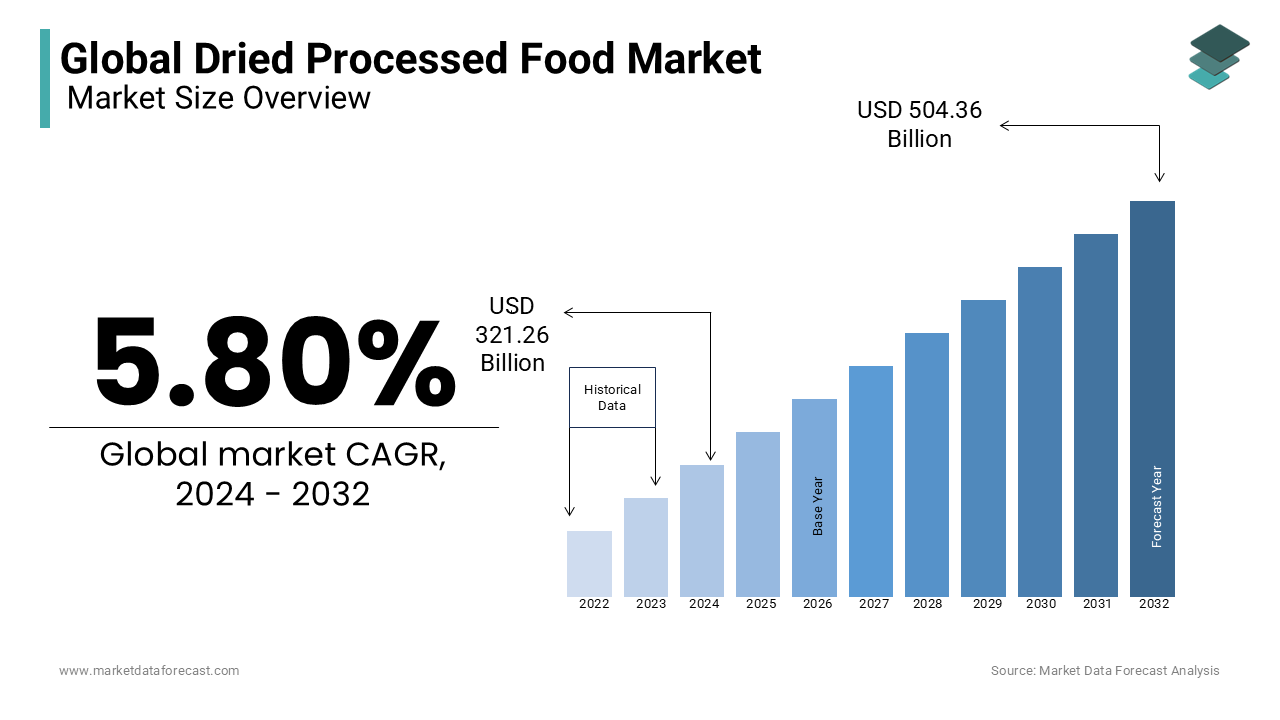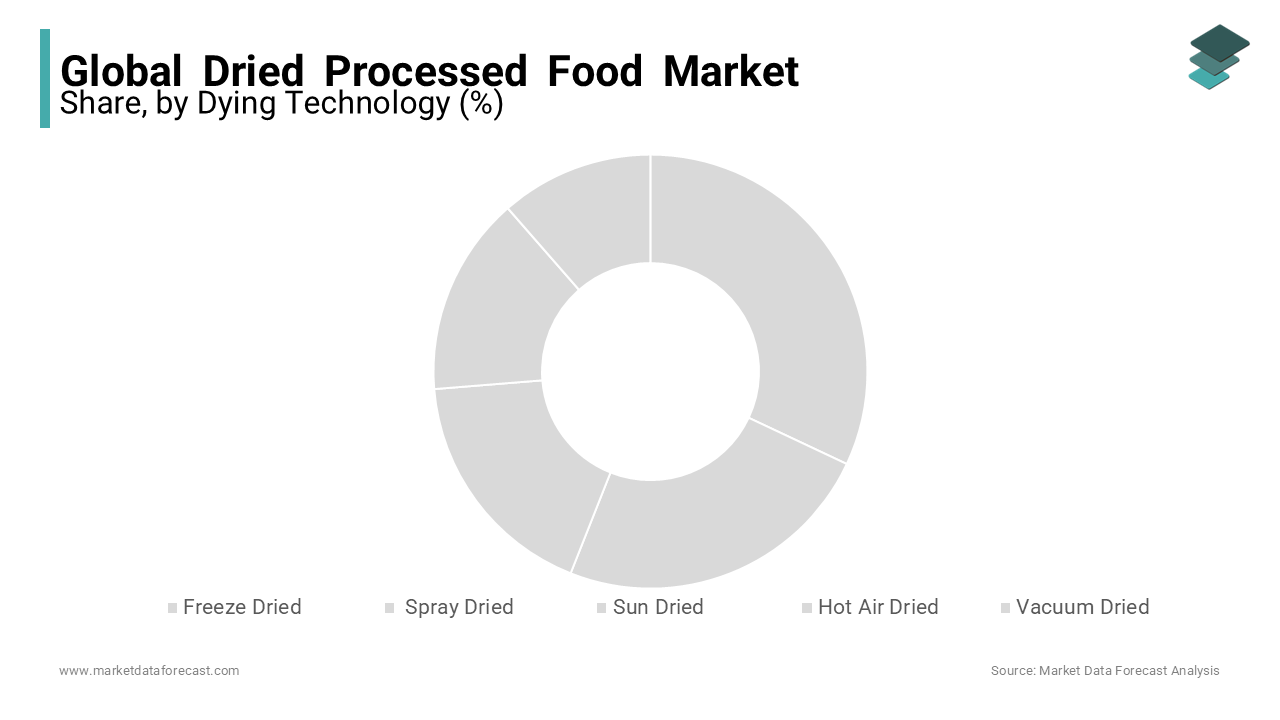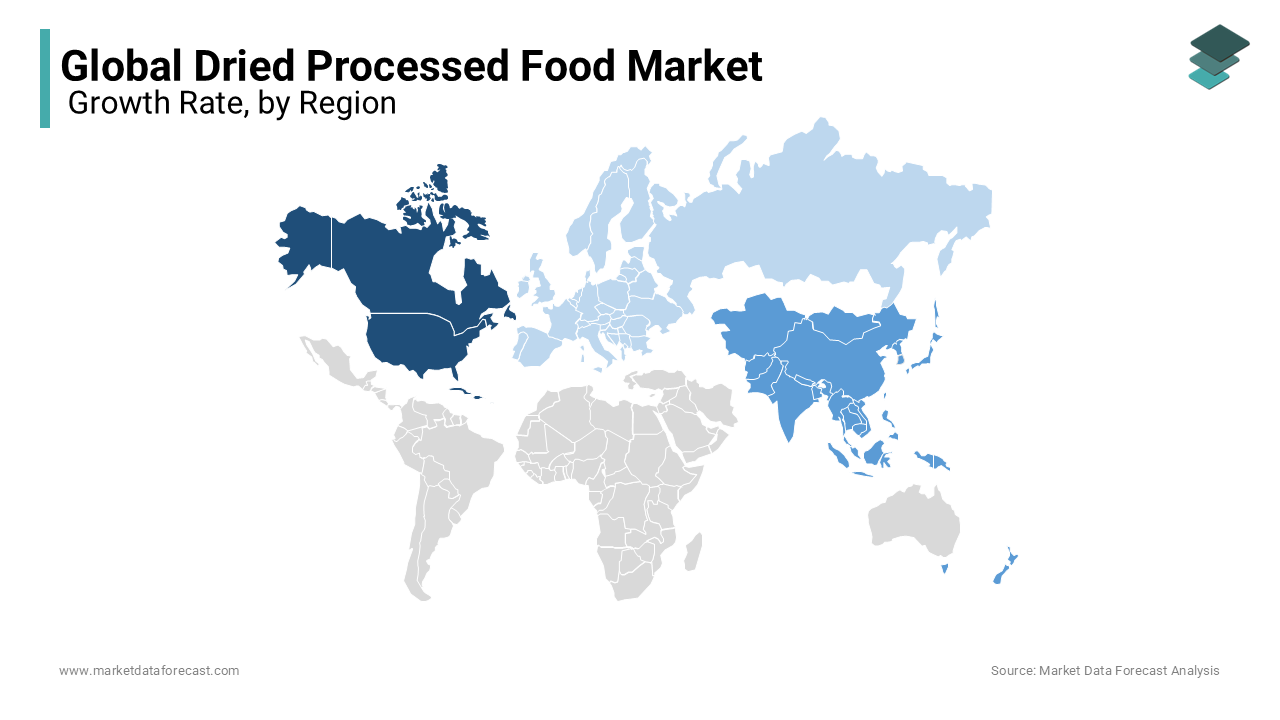Global Dried Processed Food Market Size, Share, Trends & Growth Forecast Report - Segmented By Product Type (Noodles And Dried Pasta, Dried Soup, Dessert Mixes, Dried Ready Meals, And Others), Drying Technology (Spray Dried, Freeze Dried, Sun-Dried, Vacuum Dried, Hot Air Dried, And Others), Distribution Channel (Supermarkets/Hypermarkets, Convenience Stores, Retail Stores, Online And Others), And Region(North America, Europe, Asia-Pacific, Latin America, Middle East And Africa) - Global Industry Analysis, Size, Share, Growth, Trends And Forecast 2025 To 2033
Global Dried Processed Food Market Size
The size of the global dried processed food market was expected to be worth USD 321.26 billion in 2024 and is anticipated to be worth USD 533.61 billion by 2033 from USD 339.81 billion In 2025, growing at a CAGR of 5.80% during the forecast period.

Dried processed foods are made by removing moisture from food or crops to preserve nutrients and flavorings and extend shelf life. Through drying, it is possible to remove moisture from food, with the aim of not having the ability to develop microorganisms, such as microorganisms, yeasts and fungi, and avoid food spoilage. Drying is an age-old technique for food handling, ensuring food flavor and supplementation, making this food available year-round. Dried processed foods are available in various types, including pasta and noodles, ready meals, and soups. In addition, the drying process of food helps to stop the growth of microorganisms. As consumer awareness of the improved shelf life of dried processed foods increases, adoption of dry processed foods increases among consumers, especially in developing countries.
MARKET DRIVERS
Increased consumption of prepackaged and processed foods is one of the key factors driving growth in the global dried processed foods market.
As the demand for gluten-free products increases among health-conscious people, food manufacturers are providing organic processed foods to increase the growth of the dried processed foods market. The growing demand for prepared foods among the workforce is expected to support sales growth in the dried processed foods market. Changes in consumer purchasing patterns affect the expansion of product portfolios based on the needs of manufacturers' consumers, which is expected to increase global dried processed food market growth. In addition, technological advancements in packaging technology and product differentiation are some of the factors that are expected to drive growth in the dried processed food market. Also, as the number of working women increases, the demand for dry processed foods, such as dry pasta and noodles, soups and desserts, is likely to increase further. Additionally, the high nutritional content of dry processed foods has attracted the attention of many health-related consumers worldwide. The growth of the dried processed food market has been driven by busy lifestyles, increased work pressure and increased leisure preferences. Also, as the preference for gluten-free foods increases due to health issues, the dried processed food market is expected to open worldwide. Although the dried processed foods market is expanding at a significant rate, there are several orders limiting the market, such as loss of supplements and first taste of items and high assembly and production costs. The expression of processed foods without gluten and original flavor is based on the increase in market development in the coming years.
Additionally, the high nutritional content of dried processed foods can be consumed at any time of the day, attracting the attention of several health-conscious consumers around the world. The market is driven by lifestyle and eating habits, and there is a demand for convenient food with low cost and longer shelf life. The global dried processed food market is fueled by a change in lifestyle and the inclination of the diet and the demand for comfortable foods with lower costs and longer usage times. In any case, the dry processed food market has opened a big door with the increase in the ubiquity of cooked foods and the launch of imaginative dry acid gluten processed foods on the dried processed food market. As buyers' interest and awareness of the benefits of gluten-free foods increases, key players must update their product portfolio and establish their essence in markets around the world. Dry-prepared meals, dry noodles and pasta, and many other dried processed foods require less time to prepare. Dried processed foods, such as pasta and noodles, are the main foods and are consumed in many countries. Due to the busy lifestyle and the need for leisure, convenient food is needed. Due to growing health awareness, food manufacturers are concentrating on the use of natural, organic, functional, highly effective and low toxicity food additives in these dried processed foods. The increase for the consumption of organic processed foods and gluten-free food due to health concerns is likely to increase the global dried processed food market growth.
MARKET RESTRAINTS
The strong presence of local manufacturers leads to market fragmentation, which can hinder the growth of the dried processed food market in the future.
REPORT COVERAGE
|
REPORT METRIC |
DETAILS |
|
Market Size Available |
2024 to 2033 |
|
Base Year |
2024 |
|
Forecast Period |
2025 to 2033 |
|
CAGR |
5.80% |
|
Segments Covered |
By Drying Technology, Product Types, Distribution Channel, And Region |
|
Various Analyses Covered |
Global, Regional & Country Level Analysis, Segment-Level Analysis, DROC; PESTLE Analysis. Porter’s Five Forces Analysis, Competitive Landscape; Analyst Overview of Investment Opportunities |
|
Regions Covered |
North America, Europe, APAC, Latin America, Middle East & Africa |
|
Market Leaders Profiled |
B&G Foods, Ajinomoto Co. Inc, Campbell, Hagoromo Foods Corp, Nestlé, General Mills Inc, Impulse and Indulgence Products, Kraft Foods Inc, Jinmailang Food Co. Ltd, and Unilever Ltd |
SEGMENTAL ANALYSIS
Global Dried Processed Food Market Analysis By Drying Technology

The freeze-dried segment holds the dominant share of the dried processed food market. Any food that is changed from its original state in some way to increase its shelf life is attributed to elevating the need for various prices and is expected to showcase huge demand for freeze-dried food products. The prominence of making foods maintain their quality with various technological developments is certainly to enhance the dried processed methods. These foods are perfect during an emergency, as they promote healthy snacks or any food items that do not take much time to cook.
The dried segment holds the dominant share of the market. This technology has various advantages in industries like F&B, pharmaceuticals, and others. This technology produces extremely fine particle-size substances which are premium to use in various food products. Instant soups, coffee powder, and dry milk powder are some of the best examples of products made using this technology. In the coming years, the rising demand for dried and processed food products across the world may showcase huge opportunities for the market to grow.
Global Dried Processed Food Market Analysis By Product Types
The dry pasta and noodles segment is expected to have the highest share of the dried processed food market. The priority of making easy and tasty food at home, which usually takes very little time to cook, especially among urban people, is solely to elevate the growth rate of the market. Many people prefer to eat pasta and noodles irrespective of the region, which are widely available with different styles of recipes. Therefore, ready-to-cook or ready-to-eat products that are processed with advanced or innovative techniques in the food and beverage industry are likely to showcase potential opportunities for the market in the coming years.
The dessert mix segment is likely to have the highest growth rate in the market. Rising consumer preferences towards a variety of desserts with various flavors are ascribed to bolster the growth rate of the market.
Global Dried Processed Food Market Analysis By Distribution Channels
The convenience stores segment is deemed to have the highest share of the dried processed food market. These stores promote newly launched food or beverages to reach out to target customers, which is more likely to enhance the growth rate of the market. Also, the flexibility to choose various products from random brands is likely to promote the market’s growth rate.
The online segment is gaining huge traction over the growth rate of the market these days with the rising number of people adapting to various food delivery applications. Ordering food products through online applications has become very easy in this modern era, where the prominence of delivering high-quality food products drives the growth rate of the market.
REGIONAL ANALYSIS

North America has the main dried processed food market on the planet, which is trailed by Europe and Asia Pacific. The North American dried processed food market is attributed to increased consumption of processed foods. Also, a growing number of working women is another factor projected to drive growth of the target market in this region. The dried processed food market in Asia Pacific is expected to contribute significantly to the dried processed foods market, revenue share, due to the strong presence of food manufacturing companies and the inclination towards ready-to-eat foods.
The Asia Pacific area is likely to have the fastest development rate in the middle of the estimated time frame attributable to increased utilization in nations, for example India, China and Japan. Much of the district's development can be attributed to the growing interest in rice and noodles from emerging economies such as China, India, Indonesia, Malaysia, the Philippines, Thailand, and Vietnam. Besides, industrialization, the change in the food consumption preferences of the population, rapid urbanization, together with the increase in disposable income, are some factors that are expected to drive the growth of the dried processed food market in several countries in this region. Factors, for example, high energy purchases from shoppers and an expansion in food consumption, will drive interest in advantageous foods, such as dry noodles and prepared dinners in the area in the coming years.
The European dried processed food market is expected to register substantial growth, due to the high consumption of noodles and pasta as a staple food. Europe is the second-largest consumer of dry food products; Some parts of Europe, such as the United Kingdom, France, Germany and Italy are important markets. The higher the level of processing, the higher the level of product differentiation, can be attributed to highly sophisticated R&D capacity in these developing countries. Manufacturers of dried processed foods in these countries can discover what consumers want and deliver them with the product characteristics that consumers prefer.
KEY PLAYERS IN THE GLOBAL DRIED PROCESSED FOOD MARKET
Major key Players in the global dried processed food market are B&G Foods, Ajinomoto Co. Inc, Campbell, Hagoromo Foods Corp, Nestlé, General Mills Inc, Impulse and Indulgence Products, Kraft Foods Inc, Jinmailang Food Co. Ltd, and Unilever Ltd
DETAILED SEGMENTATION OF THE GLOBAL DRIED PROCESSED FOOD MARKET INCLUDED IN THIS REPORT
This research report on the global dried processed food market has been segmented and sub-segmented based on drying technology, product types, distribution channel, and region.
By Drying Technology
- Freeze Dried
- Spray Dried
- Sun Dried
- Hot Air Dried
- Vacuum Dried
- Others
By Product Types
- Dry Pasta And Noodles
- Dry Soups
- Dry Prepared Foods
- Dessert Mixes
- More
By Distribution Channels
- Convenience Stores
- Retail Stores
- Hypermarkets/Supermarkets
- Online
- Others
By Region
- North America
- Europe
- Asia and Pacific
- Latin America
- Middle East and Africa
Frequently Asked Questions
1. What are the latest trends in the dried processed food market?
Recent trends include a rise in organic and non-GMO options, innovative packaging for better preservation, and increased demand for plant-based and gluten-free dried foods.
2. What factors are driving the growth of the dried processed food market?
Key factors include the increasing demand for convenience foods, a growing interest in healthy snacking, advancements in drying technology, and the rising popularity of plant-based diets.
3. How is technology impacting the dried processed food market?
Advancements in drying technology, such as improved freeze-drying techniques and better packaging solutions, are enhancing the quality and shelf life of dried processed foods.
Related Reports
Access the study in MULTIPLE FORMATS
Purchase options starting from $ 2500
Didn’t find what you’re looking for?
TALK TO OUR ANALYST TEAM
Need something within your budget?
NO WORRIES! WE GOT YOU COVERED!
Call us on: +1 888 702 9696 (U.S Toll Free)
Write to us: sales@marketdataforecast.com